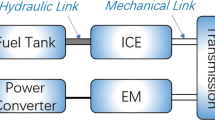Abstract
In recent times, the utilization of autonomous vehicles (AVs) has been significantly increased over the globe. It is because of the tremendous rise in familiarity and the usage of artificial intelligence approaches in distinct application areas. Though AVs offer several benefits like congestion control, accident prevention, and so on, energy management and traffic flow prediction (TFP) remain a challenging issue. This paper concentrates on the design of intelligent energy management and TFP (IEMTFP) technique for AVs using multi-objective reinforced whale optimization algorithm (RWOA) and deep learning (DL). The proposed model involves an energy management module using fuzzy logic system to reach the specified engine torque with respect to different measures. For optimal tuning of the variables involved in the fuzzy logic membership functions (MFs), RWOA is employed to further reduce the energy utilization. Besides, the proposed model uses a DL-based bidirectional long short-term memory (Bi-LSTM) technique to perform TFP. For validating the efficacy of the IEMTFP technique, an extensive experimental validation is carried out. The resultant values ensured the goodness of the IEMTFP model in terms of energy management and TFP.











Similar content being viewed by others
References
Avudaiappan T, Balasubramanian R, Pandiyan SS, Saravanan M, Lakshmanaprabu SK, Shankar K (2018) Medical image security using dual encryption with oppositional based optimization algorithm. J Med Syst 42(11):208
Chen H, Yang C, Heidari AA, Zhao X (2020) An efficient double adaptive random spare reinforced whale optimization algorithm. Exp Syst Appl 154:113018
Guerra E (2016) Planning for cars that drive themselves. J Plan Edu Res 36(2):210–224
Hwang I, Jang YJ, Jin M (2017) Overhead hoist transport route guidance algorithm using Q (λ) learning method in automated material handling system. In: Proceedings of the 24th international conference on production research. The International Conference on Production Research.
Kabir QS, Suzuki Y (2019) Comparative analysis of different routing heuristics for the battery management of automated guided vehicles. Int J Prod Res 57(2):624–641
Kaplin B, Peterson S (2017) Connected and autonomous vehicles and the boston MPO: a first look. Boston Region Metropolitan Planning Organization, Boston
Khayyam H, et al. (2008) A rule-based intelligent energy management system for an internal combustion engine vehicle. in TENCON 2008–2008 IEEE Region 10 Conference. IEEE.
Kockelman K, Boyles S, Stone P et al (2017) An assessment of autonomous vehicles: traffic impacts and infrastructure needs. University of Texas at Austin, Austin
Koot M et al (2005) Energy management strategies for vehicular electric power systems. IEEE Trans Vehic Technol 54(3):771–782
Koot M et al (2006) Fuel reduction potential of energy management for vehicular electric power systems. Int J Altern Propuls 1(1):112–131
Kumar S, Solanki VK, Choudhary SK, Selamat A, González Crespo R (2020) Comparative study on ant colony optimization (ACO) and K-means clustering approaches for jobs scheduling and energy optimization model in internet of things (IoT). Int J Interact Multimedia Artif Intell 6(1).
Lee S, Lee J, Na B (2018) Practical routing algorithm using a congestion monitoring system in semiconductor manufacturing. IEEE Trans Semicond Manuf
Liao S, Chen J, Hou J, Xiong Q, Wen J (2018) Deep convolutional neural networks with random subspace learning for short-term traffic flow prediction with incomplete data. In: Proceedings of the 2018 international joint conference on neural networks, IJCNN, IEEE, pp. 1–6.
Liu F et al (2019) Can autonomous vehicle reduce greenhouse gas emissions? A country-level evaluation. Energy Policy 132:462–473
Ma X, Dai Z, He Z, Ma J, Wang Y, Wang Y (2017) Learning traffic as images: a deep convolutional neural network for large-scale transportation network speed prediction. Sensors 17(4):818
Mahmoud K, Abdel-Nasser M, Kashef H, Puig D, Lehtonen M (2020) Machine learning based method for estimating energy losses in large-scale unbalanced distribution systems with photovoltaics. Int J Interact Multimedia Artif Intell 6(4).
Mirjalili S, Lewis A (2016) The whale optimization algorithm. Adv Eng Softw 95:51–67
Phan D, Bab-Hadiashar A, Lai CY, Crawford B, Hoseinnezhad R, Jazar RN, Khayyam H (2020) Intelligent energy management system for conventional autonomous vehicles. Energy 191:116476
Poursamad A, Montazeri M (2008) Design of genetic-fuzzy control strategy for parallel hybrid electric vehicles. Control Eng Pract 16(7):861–873
Rothe J, Gaxiola G, Marshall L, Asakawa T, Yamagata K, Yamamoto M (2015) Novel approaches to optimizing carrier logistics in semiconductor manufacturing. IEEE Trans Semicond Manuf 28(4):494–501
Shaheen S, Cohen A, Zohdy I (2016) Shared mobility: current practices and guiding principles. US Department of Transportation, Washington
Shankar K, Lakshmanaprabu SK, Gupta D, Khanna A, de Albuquerque VHC (2020) Adaptive optimal multi key based encryption for digital image security. Concurr Comput Pract Exp 32(4):e5122
Transportation, U.S.D.o. (2018) Shared-use mobility includes all transportation services that are shared among users, such as public transit, ridesourcing, transportation network companies, and taxis. In: Federal Transit Administration, Shared Mobility Definitions.
Valayapalayam Kittusamy, S. R., Elhoseny, M., & Kathiresan, S. (2019). An enhanced whale optimization algorithm for vehicular communication networks. Int J Commun Syst e3953.
Won JS, Langari R (2005) Intelligent energy management agent for a parallel hybrid vehicle-part II: torque distribution, charge sustenance strategies, and performance results. IEEE Trans Vehic Technol 54(3):935–953
Acknowledgments
The authors would like to thank the anonymous reviewers for their critical and constructive comments, their thoughtful suggestions have helped improve this paper substantially. Irina V. Pustokhina is thankful to the Department of Entrepreneurship and Logistics, Plekhanov Russian University of Economics, Moscow, Russia. K. Shankar would like to thank RUSA PHASE 2.0, Dept. of Edn. Govt. of India.
Author information
Authors and Affiliations
Corresponding author
Ethics declarations
Conflict of interest
The authors declare that they have no conflict of interest. The manuscript was written through contributions of all authors. All authors have given approval to the final version of the manuscript.
Additional information
Communicated by Vicente Garcia Diaz.
Publisher's Note
Springer Nature remains neutral with regard to jurisdictional claims in published maps and institutional affiliations.
Rights and permissions
About this article
Cite this article
Manne, S., Lydia, E.L., Pustokhina, I.V. et al. An intelligent energy management and traffic predictive model for autonomous vehicle systems. Soft Comput 25, 11941–11953 (2021). https://doi.org/10.1007/s00500-021-05614-7
Published:
Issue Date:
DOI: https://doi.org/10.1007/s00500-021-05614-7




